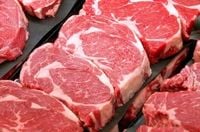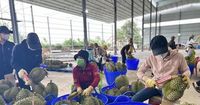Global trade in meat and seafood has continued to show remarkable shifts in 2025, with both Norway and Australia posting record-breaking figures in several categories, while also facing notable declines in others. The latest data released by the Norway Seafood Council (NSC) and Meat & Livestock Australia (MLA) paint a vivid picture of changing consumer preferences, evolving market dynamics, and the impact of strategic partnerships across continents.
Norwegian seafood exports to Vietnam have taken a significant leap in both value and volume, reflecting a broader surge in demand for high-quality, sustainably sourced products. According to the NSC, in the first seven months of 2025, Norway exported 32,400 tons of seafood to Vietnam, valued at 1.5 billion NOK—approximately $152 million USD. While the overall export volume remained stable compared to the same period last year, the export value jumped by 17%. This indicates a shift toward higher-value products and perhaps a premiumization of Norwegian seafood in the Vietnamese market.
Salmon continues to reign supreme among Norwegian exports, with 12,500 tons shipped to Vietnam in the period, marking an 18% increase year-on-year. The export value of salmon also rose by 7%, reaching 628 million NOK (about $63 million USD). Notably, fresh salmon exports soared by 42% to 4,900 tons, while frozen salmon products increased 12% to 5,500 tons. This uptick in frozen salmon is partially attributed to the growing popularity of sushi in Vietnam, particularly the demand for salmon belly meat.
Mackerel, another Norwegian staple, also saw impressive gains. Exports to Vietnam reached 11,900 tons, up 22% from the first seven months of 2024, with export value climbing 59% to 332 million NOK (about $33.6 million USD). These figures underscore the growing appetite among Vietnamese consumers for fresh, high-quality seafood that meets sustainable farming and harvesting standards.
"Vietnam is one of the most important export markets for Norwegian salmon in Southeast Asia due to impressive growth," said Åshild Nakken, NSC Southeast Asia Regional Director, at a cooperation signing event with Vietnamese restaurant chains held at the end of August 2025. She also highlighted that the foundation of Norway's seafood industry is its commitment to responsible development and maintaining the natural balance of the environment. Norway's deep fjords, with their cold, clean, and continuously circulating seawater, create an ideal environment for natural salmon growth.
This commitment to sustainability, coupled with strategic partnerships between the NSC and local Vietnamese importers, distributors, retailers, and food service businesses, has made Norwegian seafood increasingly accessible in Vietnam. According to the NSC, these collaborations have been instrumental in meeting the rising demand for premium seafood products.
The broader Southeast Asian market has also experienced a surge in Norwegian seafood imports. In the first seven months of 2025, Norway exported 88,500 tons of seafood to Southeast Asia, a 13% increase year-on-year, valued at 5.4 billion NOK (about $546 million USD)—a 10% jump. The primary drivers of this growth have been strong demand for salmon, rainbow trout, and mackerel. Exports of fresh salmon and rainbow trout to the region rose 31% in volume to 41,259 tons, with export value increasing 4% to 3.5 billion NOK (about $354 million USD).
Looking back at 2024, Norway exported a total of 2.8 million tons of seafood worldwide, valued at $16.5 billion USD. Of this, 72,078 tons were shipped to Vietnam, worth $252 million USD—a 16% increase in volume and a 20% rise in value compared to 2023. Salmon alone accounted for 24,000 tons, cementing Vietnam's position as one of the largest Norwegian seafood consumer markets in Southeast Asia.
Meanwhile, on the other side of the globe, Australia’s red meat industry has experienced a dynamic year, with beef exports reaching new heights. According to MLA data, Australia exported 135,571 tons of beef in August 2025, an 11% increase compared to August 2024. This is the largest August export volume ever recorded and the second largest monthly total in 2025, trailing only July. Most of this growth came from North Asian markets.
The United States remained the largest market for Australian beef in August 2025, importing 40,754 tons, though this represented a slight 1% decrease year-on-year. China, however, saw a dramatic 47% increase, importing 22,323 tons, making it the second-largest market. South Korea followed closely, with a 22% year-on-year increase to 21,495 tons. Canada posted the most striking growth, with imports rising 145% to 6,001 tons, making it the fifth-largest market for Australian beef.
Australia’s grain-fed beef exports in August 2025 rose 9% year-on-year to 97,286 tons, while grass-fed beef exports jumped 16% to 38,284 tons—the third highest grain-fed export volume on record. Notably, grain-fed beef exports have been on a strong upward trajectory for 15 consecutive months since early 2024, reflecting robust demand and possibly a shift in consumer preferences for this type of meat.
However, not all sectors have enjoyed such positive momentum. Lamb meat exports in August 2025 declined compared to August 2024. Mature lamb meat exports fell 25% to 22,471 tons, while young lamb meat exports dropped 33% to 12,642 tons. Despite the decrease, the U.S. increased its market share of mature lamb meat to 28%, up from 23% the previous year, even as total exports to the U.S. declined 10% to 6,271 tons.
The Chinese market for Australian lamb also softened, with total exports down 27% to 7,300 tons. This was primarily due to a steep 62% drop in young lamb meat exports, though mature lamb meat exports to China bucked the trend, increasing 30% to 4,926 tons. The Middle East and North Africa region saw a 54% decrease in mature lamb meat imports, with all countries except the United Arab Emirates—which remained steady at 1,690 tons—experiencing declines. Southeast Asia also saw a 30% year-on-year fall in total lamb meat imports in August 2025, with Malaysia’s imports of young and mature lamb meat dropping 24% and 63%, respectively.
In contrast, Australia’s goat meat exports have surged. August 2025 saw a 20% year-on-year increase to 4,975 tons, the highest August volume ever and the fifth largest monthly export on record. All major markets showed growth: U.S. imports rose 22% to 2,608 tons, South Korea 10% to 887 tons, China 17% to 390 tons, and Canada 76% to 251 tons. For the first eight months of 2025, total goat meat exports reached 37,769 tons, up 20% year-on-year and the highest on record for that period.
The global landscape for meat and seafood trade in 2025 is a story of both resilience and adaptation. While Norwegian seafood continues to expand its reach in Southeast Asia, fueled by sustainability and strategic partnerships, Australia’s red meat sector demonstrates the volatility and opportunity inherent in international markets. As consumer tastes evolve and global supply chains adapt, these trends are likely to shape the future of food on dinner tables from Hanoi to Houston.



